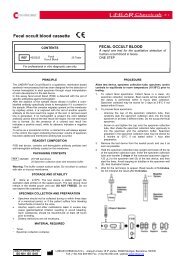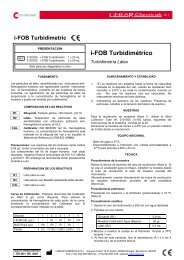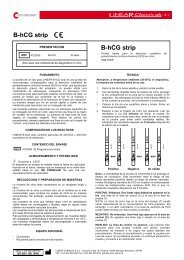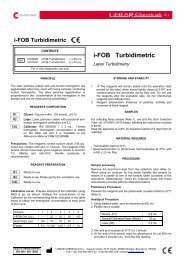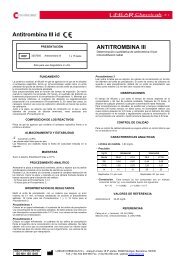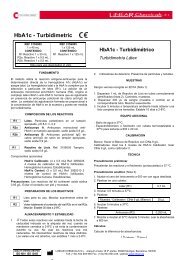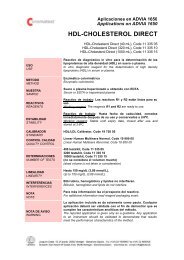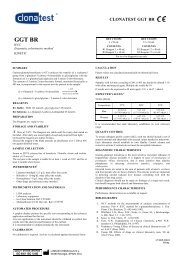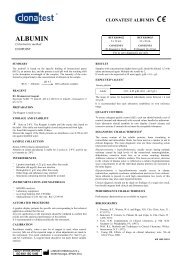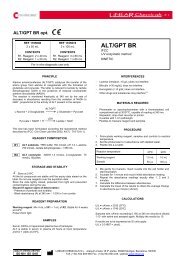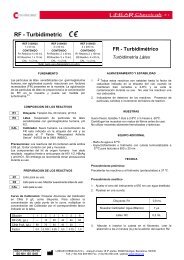CHOLESTEROL MR - Linear
CHOLESTEROL MR - Linear
CHOLESTEROL MR - Linear
Create successful ePaper yourself
Turn your PDF publications into a flip-book with our unique Google optimized e-Paper software.
CLONATEST <strong>CHOLESTEROL</strong> <strong>MR</strong><br />
<strong>CHOLESTEROL</strong> <strong>MR</strong><br />
TOTAL<br />
Enzymatic colorimetric method<br />
ENDPOINT<br />
REF KR10142<br />
REF KR10145<br />
8 x 30 mL 18 x 30 mL<br />
CONTENTS<br />
CONTENTS<br />
R1.Reagent 8 x 30 mL R1.Reagent 18 x 30 mL<br />
For in vitro diagnostic use only<br />
SUMMARY<br />
This method for the measurement of total cholesterol 1,2 in serum involves<br />
the use of three enzymes: cholesterol esterase (CE), cholesterol oxidase<br />
(CO) and peroxidase (POD). In the presence of the former the mixture of<br />
phenol and 4-aminoantipyrine (4-AA) are condensed by hydrogen<br />
peroxide to form a quinoneimine dye proportional to the concentration of<br />
cholesterol in the sample.<br />
CE<br />
Cholesteryl esters<br />
Cholesterol + Fatty acids<br />
CO<br />
Cholesterol + O 2 Cholestenone + H 2 O 2<br />
H 2 O 2<br />
4-AA + Phenol<br />
Quinoneimine + 4H 2 O<br />
POD<br />
REAGENT<br />
R1. PIPES 200 mmol/L pH 7.0, sodium cholate 1 mmol/L, cholesterol<br />
esterase > 250 U/L, cholesterol oxidase > 250 U/L, peroxidase > 1 KU/L,<br />
4-aminoantipyrine 0.33 mmol/L, phenol 4 mmol/L, non-ionic<br />
tensioactives 2 g/L (w/v). Biocides.<br />
PREPARATION<br />
The Monoreagent is ready-to-use.<br />
STORAGE AND STABILITY<br />
Store at 2-8ºC. The Reagent is stable until the expiry date stated on the<br />
label. On board the reagent is stable 30 days. After daily use stored tightly<br />
closed and protected from light. Discard the reagent if presents an<br />
absorbance over 0.200 at 500 nm against distilled water.<br />
SAMPLE COLLECTION<br />
Serum, EDTA or heparinized plasma free of hemolysis.<br />
Cholesterol in serum or plasma is stable up to 5 days at 2-8ºC and for a<br />
few months at –20ºC.<br />
INTERFERENCES<br />
−<br />
−<br />
−<br />
−<br />
Lipemia (intralipid 5 g/L) may affect the results.<br />
Bilirubin (40 mg/dL) does not interfere.<br />
Hemoglobin (> 1 g/L) may affect the results.<br />
Other drugs and substances may interfere 3 .<br />
INSTRUMENTATION AND MATERIALS<br />
−<br />
−<br />
−<br />
−<br />
KROMA analyzer.<br />
Laboratory equipment.<br />
iso-Clean Solution. Ref. CT18002.<br />
Multicalibrator CC/H 10x3 mL Ref. CT19750<br />
AUTOMATED PROCEDURE<br />
A graphic display pictures the specific sets corresponding to the technical<br />
application outlined for this test.<br />
Any new application, to the instrument should be validated to confirm that<br />
results meet the analytical performance of the method.<br />
It is recommended to validate periodically the instrument.<br />
CALIBRATION<br />
Recalibrate weekly, when a new lot of reagent is used, when control<br />
recovery falls out of the expected range or when adjustments are made to<br />
the instrument. A reagent blank should be run daily before sample<br />
analysis.<br />
RESULTS<br />
Samples with concentrations higher than 600 mg/dL should be diluted 1:2<br />
with saline and assayed again. Multiply the results by 2.<br />
If results are to be expressed as SI units apply: mg/dL x 0.0259 = mmol/L<br />
EXPECTED VALUES 4<br />
Updated clinical values of total cholesterol used to classify risk groups.<br />
Total Cholesterol<br />
Risk Classification<br />
< 200 mg/dL (< 5.18 mmol/L) Desirable<br />
200-239 mg/dL (5.18-6.2 mmol/L) Borderline high<br />
> 240 mg/dL (> 6.2 mmol/L) High<br />
It is recommended that each laboratory establishes its own reference<br />
range.<br />
QUALITY CONTROL<br />
To ensure adequate quality control (QC), each run should include a set of<br />
controls (normal and abnormal) with assayed values handled as unknowns.<br />
Each laboratory should establish its own Quality Control scheme and<br />
corrective actions if controls do not meet the acceptable tolerances.<br />
DIAGNOSTIC CHARACTERISTICS<br />
The knowledge of the plasma level of lipids (cholesterol and triglycerides)<br />
together with lipoproteins of high and low density (HDL and LDL) aids in<br />
the detection of many conditions bound to metabolic disorders of high<br />
risk. The imbalance in the level of lipoproteins in plasma leads to<br />
hyperlipoproteinemias, a group of disorders that affects lipid levels in<br />
serum, causing coronary heart disease (CHD) and atherosclerosis,<br />
conditions in which the cholesterol levels are important tools in their<br />
diagnosis and classification.<br />
Jaundice of the obstructive type ussually is accompanied by an elevated<br />
total serum cholesterol with a normal ester fraction. Diabetes,<br />
hypothyroidism, and certain types of kidney disease are other disorders<br />
that may exhibit the same cholesterol disturbance.<br />
Clinical diagnosis should not be made on findings of a single test result,<br />
but should integrate both clinical and laboratory data.<br />
PERFORMANCE CHARACTERISTICS<br />
Performance characteristics are available on request.<br />
BIBLIOGRAPHY<br />
1.<br />
2.<br />
3.<br />
4.<br />
-<br />
-<br />
Allain, C.C., Poon, L.S., Clau, C.S.G, Richmond, W and Fu, P.D.<br />
Clin. Chem. 20 : 470 (1974).<br />
Tamaoku, K., Murao, Y. and Akiura, K. Analytica Chimica. Acta.<br />
136 : 121 (1982).<br />
Young DS. Effects of drugs on clinical laboratory tests, 5th ed.<br />
AACC Press, 2000.<br />
SPECIAL REPORT. Executive Summary of the Third Report of the<br />
National Cholesterol Education Program (NCEP) Expert Panel on<br />
Detection, Evaluation, and Treatment of High Blood Cholesterol in<br />
Adults (Adult Treatment Panel III). JAMA. 285 : 2486 (2001).<br />
Further hints<br />
SPECIAL REPORT (ATP III) available at:<br />
http: // www.nhlbi.nih.gov.<br />
An autoevaluation about the risk of heart disease is available at :<br />
time.com/ cholesterol<br />
KR1014-2/0811<br />
QUALITY SYSTEM CERTIFIED<br />
ISO 9001 ISO 13485<br />
LINEAR CHEMICALS S.L.<br />
08390 Montgat, SPAIN (EU)
CLONATEST <strong>CHOLESTEROL</strong> <strong>MR</strong><br />
COLESTEROL <strong>MR</strong><br />
TOTAL<br />
Método enzimático colorimétrico<br />
PUNTO FINAL<br />
REF KR10142<br />
REF KR10145<br />
8 x 30 mL 18 x 30 mL<br />
CONTENIDO<br />
CONTENIDO<br />
R1.Reactivo 8 x 30 mL R1.Reactivo 18 x 30 mL<br />
Sólo para uso diagnóstico in vitro<br />
FUNDAMENTO<br />
Este método para la determinación de colesterol total en suero 1,2 se basa<br />
en el uso de tres enzimas: colesterol esterasa (CE), colesterol oxidasa<br />
(CO) y peroxidasa (POD). En presencia de este último la mezcla de fenol<br />
y 4-aminoantipirina (4-AA) se condensan por acción del peróxido de<br />
hidrógeno, formando una quinonaimina coloreada proporcional a la<br />
concentración de colesterol en la muestra.<br />
Colesterol esterificado<br />
CE<br />
Colesterol + Acidos grasos<br />
Colesterol + O 2<br />
CO<br />
Colestenona + H 2 O 2<br />
H 2 O 2<br />
4-AA + Fenol<br />
Quinonaimina + 4H 2 O<br />
POD<br />
REACTIVOS<br />
R1. PIPES 200 mmol/L pH 7,0, colato sódico 1 mmol/L, colesterol<br />
esterasa > 250 U/L, colesterol oxidasa > 250 U/L, peroxidasa > 1 KU/L,<br />
4-aminoantipirina 0,33 mmol/L, fenol 4 mmol/L, tensioactivos noiónicos<br />
2 g/L (p/v). Biocidas.<br />
PREPARACIÓN<br />
El Monoreactivo está listo para su uso.<br />
ALMACENAMIENTO Y ESTABILIDAD<br />
Conservar a 2-8ºC. El Reactivo es estable hasta la fecha de caducidad<br />
indicada en la etiqueta. Desechar el reactivo cuando presente una<br />
absorbancia superior a 0,200 a 500 nm frente agua destilada. En el<br />
analizador es estable 30 días. Después de su uso diario, mantener bien<br />
cerrado y protegido de la luz.<br />
MUESTRAS<br />
Suero libre de hemólisis o plasma heparinizado u obtenido con EDTA.<br />
El colesterol en suero o plasma es estable unos 5 días a 2-8ºC y unos 6<br />
meses a –20ºC.<br />
INTERFERENCIAS<br />
−<br />
−<br />
−<br />
−<br />
Lipemia (intralipid 5 g/L) puede afectar los resultados.<br />
Bilirrubina (40 mg/dL) no interfiere.<br />
Hemoglobina (> 1 g/L) puede afectar los resultados.<br />
Otros medicamentos y sustancias pueden interferir 3 .<br />
EQUIPO ADICIONAL<br />
−<br />
−<br />
−<br />
−<br />
Analizador KROMA.<br />
Material de laboratorio.<br />
iso-Clean Solution. Ref. CT18002.<br />
Multicalibrator CC/H 10x3 mL Ref. CT19750<br />
TECNICA AUTOMATICA<br />
Una representación grafica visualiza los ajustes específicos correspondientes<br />
a la aplicación técnica diseñada para este ensayo.<br />
Cualquier aplicación nueva al instrumento deberá validarse para<br />
confirmar que los resultados cumplen las características del método.<br />
Se recomienda validar periódicamente el instrumento.<br />
CALIBRACION<br />
Recalibrar semanalmente, al cambiar el lote de reactivos, cuando los<br />
valores del control estén fuera del rango de aceptación o cuando se<br />
realicen ajustes en el instrumento. Se recomienda hacer un blanco del<br />
reactivo cada día de trabajo antes de analizar las muestras.<br />
QUALITY SYSTEM CERTIFIED<br />
ISO 9001 ISO 13485<br />
LINEAR CHEMICALS S.L.<br />
08390 Montgat, SPAIN (EU)<br />
CALCULOS<br />
Muestras con concentraciones superiores a 600 mg/dL deben diluirse 1:2<br />
con solución salina y repetir el ensayo. Multiplicar los resultados por 2.<br />
Para expresar los resultados en unidades SI: mg/dL x 0,0259 = mmol/L<br />
VALORES DE REFERENCIA 4<br />
Valores clínicos actualizados de colesterol total empleados para clasificar<br />
los grupos de riesgo.<br />
Colesterol Total<br />
Clasificación<br />
< 200 mg/dL (< 5,18 mmol/L) Deseable<br />
200-239 mg/dL (5,18-6,2 mmol/L) Normal alto<br />
> 240 mg/dL (> 6,2 mmol/L) Alto<br />
Se recomienda que cada laboratorio establezca su propio rango de<br />
referencia.<br />
CONTROL DE CALIDAD<br />
Para un control de calidad (CC) adecuado, se incluirán en cada serie<br />
controles valorados (normal y abnormal) que se tratarán como muestras<br />
problema.<br />
Cada laboratorio debe establecer su propio Control de Calidad y sus<br />
medidas correctoras cuando los controles no cumplan con las tolerancias<br />
exigidas.<br />
SIGNIFICADO CLINICO<br />
El conocimiento del nivel lipídico plasmático (colesterol y triglicéridos)<br />
junto con el de las lipoproteínas de alta y baja densidad (HDL y LDL) son<br />
de gran ayuda en la detección de muchas condiciones ligadas a<br />
alteraciones metabólicas de alto riesgo. El desequilibrio del nivel de<br />
lipoproteínas plasmáticas conduce a las hiperlipoproteinemias, grupo de<br />
desórdenes que afectan los niveles de lípidos séricos causantes de la<br />
enfermedad cardíaca coronaria (ECC) y la arterioesclerosis, en las que los<br />
niveles de colesterol son importantes en su diagnóstico y clasificación.<br />
La ictericia de tipo obstructivo va acompañada por lo general de una tasa<br />
de colesterol total elevada, con una fracción normal de colesterol<br />
esterificado. La diabetes, el hipotiroidismo y ciertas enfermedades renales<br />
exhiben el mismo tipo de desequilibrio.<br />
El diagnóstico clínico no debe realizarse únicamente con los resultados de<br />
un único ensayo, sino que debe considerarse al mismo tiempo los datos<br />
clínicos del paciente.<br />
CARACTERISTICAS ANALITICAS<br />
Las características analíticas están disponibles bajo solicitud.<br />
REFERENCIAS<br />
1.<br />
2.<br />
3.<br />
4.<br />
-<br />
-<br />
Allain, C.C., Poon, L.S., Clau, C.S.G, Richmond, W y Fu, P.D.<br />
Clin. Chem. 20 : 470 (1974).<br />
Tamaoku, K., Murao, Y. y Akiura, K. Analytica Chimica. Acta. 136<br />
: 121 (1982).<br />
Young DS. Effects of drugs on clinical laboratory tests, 5th ed.<br />
AACC Press, 2000.<br />
SPECIAL REPORT. Executive Summary of the Third Report of the<br />
National Cholesterol Education Program (NCEP) Expert Panel on<br />
Detection, Evaluation, and Treatment of High Blood Cholesterol in<br />
Adults (Adult Treatment Panel III). JAMA. 285 : 2486 (2001).<br />
Información adicional<br />
SPECIAL REPORT (ATP III) disponible en:<br />
http: // www.nhlbi.nih.gov.<br />
Una autoevaluación sobre el riesgo de enfermedad cardiaca se halla<br />
disponible en : time.com/ cholesterol
Aplicaciones en KROMA<br />
Applications on KROMA<br />
<strong>CHOLESTEROL</strong> <strong>MR</strong><br />
One reagent method<br />
Cholesterol <strong>MR</strong> (8 x 30 mL), Code KR10142<br />
Cholesterol <strong>MR</strong> (18 x 30 mL), Code KR10145<br />
USO<br />
USE<br />
METODO<br />
METHOD<br />
MUESTRA<br />
SAMPLE<br />
REACTIVOS<br />
REAGENTS<br />
CALIBRADOR<br />
STANDARD<br />
CONTROL CALIDAD<br />
QUALITY CONTROL<br />
DETERMINACIONES<br />
NUMBER OF TESTS<br />
LINEALIDAD<br />
LINEARITY<br />
NOTA<br />
NOTE<br />
NOTA DE AVISO<br />
WARNING<br />
Reactivo de diagnóstico in vitro para la determinación de colesterol<br />
en suero o plasma.<br />
In vitro diagnostic reagent for the determination of cholesterol in serum or<br />
plasma.<br />
Colorimétrico.<br />
Colorimetric.<br />
Suero o plasma recogido en EDTA libre de hemólisis.<br />
Serum or EDTA plasma free of hemolysis.<br />
El monoreactivo R1 esta listo para su uso.<br />
The monoreagent R1 is ready to use.<br />
<strong>Linear</strong> Multicalibrator CC/H, Code CT19750<br />
<strong>Linear</strong> Human Multisera Normal CT19800<br />
<strong>Linear</strong> Human Multisera Abnormal CT19850<br />
1200 tests/kit, Code KR10142<br />
2700 tests/kit, Code KR10145<br />
(no se considera el volumen muerto).<br />
(dead volume is not taken in consideration).<br />
Sin post-dilución automática: Hasta 600 mg/dL<br />
Without automatic post-dilution: Up to 600 mg/dL<br />
Para más información lea el prospecto del reactivo.<br />
For additional information read reagent packaging insert.<br />
La aplicación incluida se da solamente como pauta. Cualquier<br />
aplicación deberá ser validada con el fin de demostrar que se<br />
cumplen las características analíticas del método.<br />
The reported application is given only as a guideline. Any application to an<br />
instrument should be validated to demonstrate that results meet the<br />
performance characteristics of the method.<br />
QUALITY SYSTEM CERTIFIED<br />
ISO 9001 ISO 13485<br />
LINEAR CHEMICALS S.L.<br />
08390 Montgat, SPAIN (EU)
KROMA<br />
<strong>CHOLESTEROL</strong> <strong>MR</strong><br />
Name N. of Standards N. of rep. Units Stability<br />
Cholesterol <strong>MR</strong> 2 1 mg/dL<br />
*<br />
* entered by the user KR10142-45-1/0907<br />
QUALITY SYSTEM CERTIFIED<br />
ISO 9001 ISO 13485<br />
LINEAR CHEMICALS S.L.<br />
08390 Montgat, SPAIN (EU)



